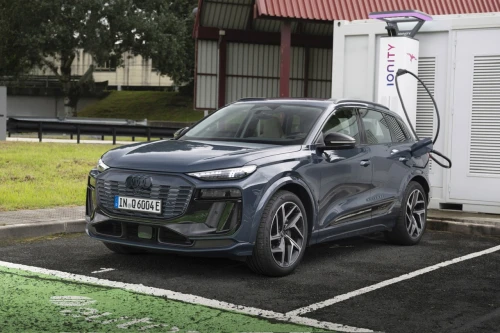Audi of America announced estimated range specifications and delivery timings for the all-new 2025 Q6 e-tron (earlier post). Expected to arrive in US dealerships in the fourth quarter of 2024, the all-new Q6 e-tron brings Audi electrification to the largest automotive segment—the mid-size luxury SUV segment.

As the first Audi model built on the all-new Premium Platform Electric (PPE), the Q6 e-tron and SQ6 e-tron represent the brand’s fourth fully electric model line. The Q6 e-tron is the new benchmark for the brand balancing driving dynamics, range, lighting and infotainment technologies, and everyday usability.
The Q6 e-tron had a a preliminary manufacturer’s estimated electric driving range of more than 300 miles on the EPA test cycle with standard equipment. Due to the high-degree of scalability with the PPE, future Q6 e-tron models will include rear wheel drive, a sleek Sportback variant and more potent RS versions; each expected to be announced from 2025 onward and joining the US lineup.
The 2025 Audi Q6 e-tron will launch in the U.S. with the Q6 e-tron quattro and SQ6 e-tron, both of which come standard with all-wheel drive. The Q6 e-tron quattro offers 422 hp (456 hp with launch control), delivering an estimated 0-60 mph time of 4.9 seconds with launch control from its two (F/R) electric motors. A top track speed of 130 mph, and 307 miles of electric range are expected on the EPA test cycle with standard equipment, based on preliminary manufacturer estimates. The Q6 e-tron comes standard with 19-inch wheels, with optional 20-inch designs available.
The SQ6 e-tron makes 483 hp (509 hp with launch control) and delivers an estimated 0-60 mph time of 4.1 seconds with launch control, a top track speed of 143 mph, and is expected to achieve an electric range of 276 miles on the EPA test cycle with standard equipment, based on preliminary manufacturer estimates. Beyond the additional power, the SQ6 comes standard with 20-inch wheels (with 21-inch wheels available), red brake calipers, and a sport adaptive air suspension.
Both the Q6 e-tron and SQ6 e-tron models feature 5-link independent front and rear suspensions, and are rated to tow up to 4,400 pounds, making them easily capable of towing a pair of trailered jet skis, or pop-up/small travel trailers.
As part of the new PPE, Q6 e-tron quattro models include a new asynchronous AC induction motor (ASM) on the front axle as well as a newly designed permanently excited synchronous AC motor (PSM) on the rear axle. The motors’ compact designs were engineered for scalability and adaptation based on application; in addition to the Q6 e-tron, the motors will power a number of future Audi products underpinned by the new PPE architecture.
Torque output can be varied by simply adjusting the length of the motor. The new electric motors also require about 30% less installation space than those previously used in other Audi EV models. Additionally, the new design has made it possible to reduce the weight of the motor by about 20% from similarly sized previous generation Audi motors. The front ASM motor, operating at a 9.191:1 final drive ratio, weighs only 193 pounds; while the rear motor (9.242:1 final drive ratio), weighs only 261 pounds.
A significant advantage of the redeveloped electric motors is their efficiency. The primary contributors to this are a new hairpin design of the windings in the stator, the addition of silicon carbide semiconductors in the pulse width modulating inverter, and a dry-sump electric oil pump in the transmission.
The new hairpin winding maximizes current conduction in the electric motor’s stator and allows for higher winding counts. The fill factor has increased to 60%, instead of 45% when compared to the previously used conventional motor windings. In total, losses caused by drag in the electric drive systems were reduced by approximately 50% from the first-generation of Audi electric drive systems.
When accelerating under full power, the asynchronous motor (ASM) on the front axle of Q6 e-tron quattro models is almost instantly engaged. Due to the nature of its construction, the ASM does not contain any magnets—instead generating its magnetic field through induction—so when unpowered, it can spin freely without significant drag losses. The rear axle features the extremely compact new PSM motor, which is exclusive to the Q6 e-tron series.
The direct cooling of the rear electric motor with oil via a dry-sump electric oil pump, which is used for the first time, keeps components like the stator winding and permanent magnets in the rotor in the optimal temperature range. As a result, the drive system’s power-to-weight ratio for the PPE electric drive system is about 60% higher than that of the first-generation Audi electric drive systems.
Motor acoustics have also been improved versus previous generation Audi EVs. Casting the motor mounts directly onto the housing structurally optimizes the acoustic transfer path, while segmenting the rotor reduces the amplitude of the spatial harmonics, resulting in NVH improvements over the first-generation Audi e-tron.
Battery size and charging capabilities. As part of its new PPE architecture, the 2025 Q6 e-tron features an entirely new battery structure operating at 800 volts. The lithium-ion battery pack is composed of 12 modules of 15 prismatic cells connected in series for a total of 180 cells, with a total gross capacity of 100 kWh (94.4 kWh net). The 800V technology which underpins the battery technology allows future production of the Q6 e-tron to be updated as charging capabilities advance, today however maximum DC fast-charging capacity of 270 kW is standard.
The elevated 270kW DC fast charging rate can bring the Q6 e-tron from a 10 to 80% state of charge (SoC) in about 21 minutes, and enables truly useful short charging stops, with up to 135 miles of additional range added in roughly 10 minutes at a 270 kW-equipped DC fast charging station, under ideal conditions. This elevated fast-charging capability is fundamentally enabled by the 800-volt architecture, the new preconditioning feature of the battery, and the PPE’s new predictive thermal management.
If a charging station works with 400V technology, the Q6 e-tron can also, for the first time, enable bank charging. The 800V battery is automatically divided into two batteries at equal voltage, which can then be charged in parallel up to 135 kW. Depending on the state of charge, both halves of the battery are first equalized and then charged simultaneously, shortening overall recharge times.
The Q6 e-tron arrives standard with the convenient Plug & Charge function, which streamlines the charging process at selected public charging stations. At compatible Electrify America charging stations and when activated in an account, the Plug & Charge feature will automatically authorize and confirm billing via encrypted vehicle to infrastructure (V2i) communication; activating the charger when the charging plug is inserted into the vehicle, forgoing the need to produce a credit card or RFID payment at the charger.
Standard level 2 AC charging, most commonly used with home chargers, is supported at rates up to 9.6kW (240V/40A). An optional onboard charging setup, available at a later date, will support AC charging rates up to 19.2 kW (240V/80A). The charging port covers can be conveniently opened electronically via the MMI display or opened conventionally on the cap itself with gentle pressure on its capacitive center. After the charging cable is removed, the charging port closes automatically.
A reduction in the overall number of battery cells, along with intelligent, high-performance and predictive thermal management is a key component of the charging performance of the PPE-based Q6 e-tron. Compared to the battery systems Audi has used to date, the battery for the Q6 e-tron (12 modules/180 cells) has fewer components. For comparison, the battery in the Q8 e-tron is made up of 36 modules and 432 cells. The significant enlargement of the cells in the Q6 e-tron corresponds closely to the system voltage of 800 volts, achieving the best balance between range and charging performance.
The reduction in the number of modules for the PPE batteries offers other advantages. The battery, which can be used modularly for high-floor (SUV) and flat-floor (sedan) models, requires less installation space, is lighter, and can be better integrated into the vehicle’s crash structure and cooling system. It also requires fewer cables and high-voltage connectors, and the number of bolted fastenings has been significantly reduced. Additionally, the electrical connections between the modules are shorter, which substantially reduces losses and weight.
A cooling plate integrated into the battery housing ensures homogeneous heat transfer and therefore near-optimal battery conditioning. The protective side skirts made of hot-formed steel are not affixed to the battery, but instead attached securely to the vehicle body. The underbody cladding made of fiber composite material is also new. This construction further reduces weight and improves the thermal insulation between the battery and the environment. This allows the PPE’s battery to be heated or cooled more efficiently.
For the PPE, the ratio of nickel to cobalt and manganese in the battery cells is approximately 8:1:1, with a reduced proportion of cobalt and an increased proportion of nickel.
An important component in increasing the efficiency and therefore the range of the Q6 e-tron is the advanced recuperation system. Around 95% of all everyday braking events can be handled by this setup, and the Q6 e-tron recuperates braking energy at up to 220 kW.
The regenerative braking system on the Q6 e-tron is more seamless than ever, being significantly further developed on the PPE thanks to axle-specific brake blending, which helps improve the natural brake-pedal modulation feel. The regenerative brakes also have five different modes, including a true One-Pedal Drive B-mode that will bring the vehicle to a complete stop at braking forces up to 0.25 g with no low-speed creeping. Three manual deceleration modes controlled by the steering-wheel paddles all provide the familiar low-speed creep found in combustion vehicles and can be set for strong deceleration (0.15 g), medium deceleration (0.06 g) or coasting. A fifth deceleration mode, Auto, helps optimize efficiency by utilizing the forward-facing camera to determine if regenerative braking or coasting is more efficient depending on traffic and road gradient, while also providing low-speed creep.
The battery management controller (BMC), a central control unit developed specifically for the PPE, is responsible for the current control required for fast and battery-saving charging. The BMC is completely integrated in the battery, and as part of its continuous monitoring, the twelve cell module controllers (CMS) send data such as the current module temperature or the cell voltage to the BMC, which sends its information to the high-performance computer that is part of the new E3 1.2 electronic architecture. This computer, in turn, sends data to the new predictive thermal management, which regulates the cooling or heating circulation as needed for optimal battery performance.
Efficient thermal management of the PPE architecture enables shorter charging times, increased range, and a longer service life compared to prior Audi models. Predictive thermal management uses data from the navigation system, desired route, departure timer, and customer’s usage behavior to calculate the need for cooling or heating in advance and provide it efficiently and at the right time. If a customer is using the Audi navigation system to find their way to a DC fast-charging station, the predictive thermal management prepares the DC charging process and cools or heats the battery so that it can charge faster, thus reducing charging time. The thermal management system also works with the vehicle’s navigation system to determine if there is a steep grade ahead and adjusts the battery’s temperature by appropriate cooling it to prevent a higher thermal stress.
If the driver has selected efficiency mode, the conditioning of the battery is activated later, which is designed to be able to increase range, depending on driving behavior. In dynamic mode, if the current traffic situation does not allow for dynamic driving, the thermal management will react to this and minimize the energy usage for battery conditioning.
Post-conditioning and continuous conditioning are also new in the PPE thermal management system and contribute to extended battery service life. These functions monitor the battery temperature for the car’s entire service life to help ensure the battery is kept in the optimal temperature range, such as after a high-speed-charging session, or even when the vehicle is not moving – for example in case of very hot weather.
With the thermal management system directing coolant below the modules to provide consistent temperature homogeneity within the battery, performance can be increased. The battery cooling plate is also a structural component of the battery, allowing an additional floor panel in the battery-housing space to be eliminated, with the thermal connection to the modules optimized thanks to a heat-conducting paste.
New PPE Architecture. The arrival of the Q6 e-tron marks the beginning of the second-generation of Audi electric vehicles and is the next technological leap in premium electric mobility for its customers. The PPE was developed jointly with Porsche at Audi headquarters in Ingolstadt, and will underpin several important future new models from Audi, as the brand expands its global range of e-mobility products across key market segments.
The PPE forms a key basis for the brand’s commitment to offer electric vehicles in all core segments by 2027, with its ability to underpin a variety of B- and C-segment offers. Audi has announced it will introduce more than 20 new or significantly redesigned models, half of them fully electric, over the next two years as part of its most robust portfolio refresh in brand history.
The essential components of the Premium Platform Electric (PPE) are the high-voltage battery and the electric drive systems. The electric drive systems for the PPE are built in the Audi powertrain plant in Győr, Hungary. The fundamental development goal was a scalable electric drive system with high integration, efficiency, and power density. The newly designed drive system consists of the three main components: electric motor; power electronics (pulse width modulating inverter); and transmission. Overall, each of the components stands out due to greater efficiency over first generation Audi EV components.
The PPE is functional proof of pooling expertise to make electric mobility scalable, permitting the launch of high-volume models in different segments to help expand the electrified portfolio, with the help of shared technical underpinnings. PPE has also helped bring more aspects of production in-house, with previously outsourced major components such as e-tron transmissions now manufactured by Audi.
Availability by Q4 2024. The 2025 Audi Q6 e-tron and SQ6 e-tron are anticipated to arrive in US showrooms in the fourth quarter of 2024; full pricing and options will be available later this year.
Source from Green Car Congress
Disclaimer: The information set forth above is provided by greencarcongress.com independently of Alibaba.com. Alibaba.com makes no representation and warranties as to the quality and reliability of the seller and products.




